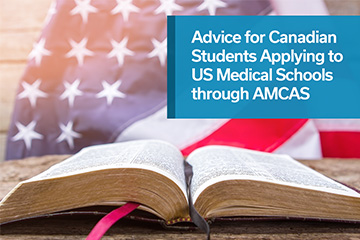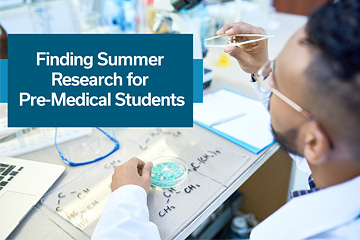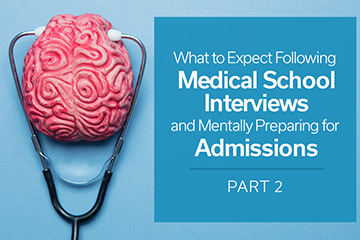
Advice for Canadian Students Applying to US Medical Schools through AMCAS
Navigating the medical school application process is very tricky. As a Canadian student, you may be less familiar with the American application and how it differs from the Canadian counterpart. I have compiled a list of things I learned during my application cycle that I am certain will get any pre-medical student off to a great start.
- Start early! – The American Medical College Application Service (AMCAS) opens much earlier than the Canadian equivalents. Usually, AMCAS becomes available in early May and can be submitted starting late May or early June. The exact dates are available on the AAMC website. It is important to keep these dates in mind for a number of reasons. Firstly, the majority of schools in the US interview students on a ‘rolling’ basis. This means that the earlier your application is submitted, the earlier it can be reviewed and considered for an interview. Another thing to keep in mind is that in the US, there are both primary and secondary applications. Once submitting your application to AMCAS (known as the primary application), AMCAS will review the application and then submit it to the schools you have selected. When the schools receive the application they will send you secondary applications for their specific program. It is important to apply as early as possible because there is a lag-time between you sending in your primary and the schools actually receiving it. The duration of this period can last several weeks and only gets longer by the time late-summer/early-fall rolls around.
- Making a tailored school list – There are a lot of things you must take into consideration when creating a list of schools to apply to. It is important to apply to schools that have historically accepted students with your student profile. Your GPA, MCAT score, hours of work/volunteer experience, and much more are all considered by schools when they make interview decisions. Unlike in Canada, the US has hundreds of schools and it can be overwhelming to figure out how to navigate them. The AAMC has created a database of all medical schools called the Medical School Admission Requirements (MSAR) that can be purchased for a small annual fee. This program will allow you to see a ton of information including median GPA/MCAT requirements, class demographics, and information about reference letters. As a Canadian, another aspect to consider is if a school even accepts Canadian students (and if so, how many). Some schools have this information on MSAR but it is safe to call the admissions offices at your prospective schools to confirm. Some schools consider Canadians only as ‘out-of-state’ applications, while others consider Canadians as ‘international’. With all this information, you should be able to formulate a school list of about 12-25 schools. Depending on your individual situation, this is likely a good number of schools as it allows you to play the numbers game without burning-out in an endless pile of applications.
- Do your secondaries before you receive them – As mentioned in the first point, you may find yourself in a situation where you have submitted the primary application to AMCAS and are awaiting your secondaries. If you are eager, you can find the secondary questions on Student Doctor Network (SDN) on school-specific threads and start working on the questions. This way, once you receive your secondary applications you can have a quick turnaround time and stay ahead of the game.
- Line up your letters of reference and transcripts before application season – If possible, it can be very helpful to have your referees put together their letters of recommendation prior to you even completing your application. The same goes for requesting your undergraduate university for your transcript. Referees have to email their letters directly to AMCAS. Similarly, your college also has to send your transcript. Since there are so many moving parts, it can get stressful if something gets delayed last minute. It is always beneficial to have it all dealt with beforehand. Protip: If you are interested in having your letters saved in a secure online database in case you are worried about having to reapply the next year, use Interfolio’s Dossier Service. This program will house your referee’s letters securely, regardless when they send them in, and distribute them to AMCAS on your command. This is great for students who get a letter of recommendation in February from a professor and don’t want to trouble them again to send it in during application season.
- Calculating your GPA – The way AMCAS calculates GPA is a bit unusual, especially for students with Canadian transcripts. Most schools in Canada report undergraduate grades as a percentage. AMCAS uses the percentage-to-letter grading legend found on your transcript (usually on the back) and then converts the letter grade to a GPA on the 4.0 scale. This final conversion is done using a table that can be found on the AAMC website. After your primary application is reviewed by AMCAS, it will be sent back to you and will display your cumulative GPA (cGPA) and science GPA (sGPA). If you see any discrepancies to what you expected, contact AMCAS.
- Interviews – When you receive an interview invite, reply as soon as possible to select a date that works best for you. Usually these invites go out in bunches and interview dates/times are on a first-come-first-serve basis. After securing the date, you will need to prepare. Figure out the style of the interview (one-on-one, panel, MMI) and use the resources available to you. The best thing you can do is run through interview questions (or MMI scenarios) with different people and get feedback. Feel comfortable talking about yourself but also handling questions on topics that might be tricky for you. Learn more about the school you are interviewing at and prepare questions you can ask during your interview to figure out if it’s a good fit for you.
- Don’t stress – Interview season is LONG. For some schools, it runs from mid-summer to late-spring. Every school operates differently and you should not get discouraged if you don’t hear back from your dream school by winter break.






